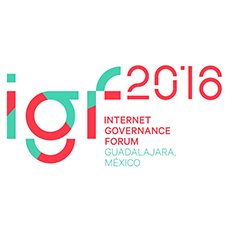Internet of things for sustainable growth
8 Dec 2016 16:00h - 17:30h
Event report
[Read more session reports and live updates from the 11th Internet Governance Forum]
This session focused on the Internet of Things (IoT) from the business perspective. The proposed questions were: How can the IoT generate wealth for everyone? How can we move this concept closer to reality?
The first speaker, Mr Shadi Abou-Zahra, Activity Lead, WAI International Program Office, pointed out that this consortium is actively looking into what they call the ‘Web of things’, which is the interface and the interoperability of connected devices and sensors. He also touched upon accessibility for persons with disabilities, recognising the power of the IoT to provide major quality of life improvements. Ten years ago smart houses with sensors were made for persons with disabilities, now they are becoming widely adopted, which can create even more creative solutions, he added.
Mr Thales Marçal Vieira Netto, Project Manager at MCTIC, gave us the Brazilian perspective on the business side approach to the issue of IoT. He mentioned the creation of the Brazilian Chamber of IoT, which represents activities of other federal agencies, alongside the national IoT plan. He was convinced that engineers are well-prepared to implement IoT and even the tech issues that might arise. Full implementation will depend on preparation of a good business plan. These plans should respond to the expectations of the municipal/local decision makers.
Ms Marcia Ogawa Matsubayashi, Financial Services Industry, Deloitte Brazil, said that IoT will significantly change how companies are organised. On a larger scale, there are some pillars on which a good business plan for the county can rely. Regional strategies, attractiveness, openness, data, and data storage are among the most important.
Pedro Maló, Professor, Faculdade de Ciências e Tecnologia da Universidade Nova de Lisboa, UNINOVA, Instituto de Desenvolvimento de Novas Tecnologias, noted that trusted IoT is a keyword. He brought in the perspective from the EU, which is funding massive research in the fields of smart agriculture, smart cities (Spanish city Santander as one example), autonomous cars, and others. Regarding infrastructure, the big question is would citizens accept to pay for building this new infrastructure without a clear notion of how this can improve their lives, he added. In his words, roaming data was also one of the major brakes for data sharing and IoT, but this will no longer be the case for the EU, since data roaming will stop existing, starting in 2017, under EU legislation. He shared his vision of the future in which we will have to pay only a small amount for the global accessibility infrastructure. Regarding security, he added that IoT devices in the future must have some kind of certification.
Mr Sam Paltridge, Directorate of Science Technology and Industry, OECD, put into perspective the amount of data that will be shared in the future via autonomous devices, especially autonomous vehicles which will need to share a significant amount of data with other users, other vehicles, and with the global network. He asked: Does all of this data need to be available in real time, or globally distributed? We don’t know what demands might be made in the future, he added. In addition, net neutrality principles and data flow prioritisation must be addressed in future discussions.
Mr Serge Mvongo, Staff Manager, Business Development, Qualcomm Intelligent Solutions|Smart Cities & IIOT, reminded us about the three types of IoT, depending on who is using it: IoT for consumers, IoT for enterprises, or IoT for cities/governments. In the field of public IoT, the most important part is determining what manner of connectivity is needed. Once we have clear goals we can find the solution on the design side. You need to break it down to the local needs, he noted.
All panellists shared common concerns about the human being in the centre of the IoT, how much data is important, and how valuable test and pilot projects are.
In a discussion with the audience, the possibility of universal global connectivity was seen as very likely. This expected ‘tsunami’ of data will certainly be solved via technology upgrades like edge computing (an analytical model that improves processing). On the other hand not all of the data generated by the future IoT would need to be exchanged on a global network. A large portion of it can be exchanged via content delivery networks, private networks, and other forms of network distribution. This is especially important for sensitive data such as health record data.
Some of the improvements in the short term certainly are the adoption of 5G networks and changes in spectrum licenses enabling potential smaller, cheaper networks, even in remote and undeveloped areas.
by Arvin Kamberi
Related topics
Related event

